

Cavalier King Charles Spaniel. The King Charles changed drastically in the late 17th century, when it was interbred with flat-nosed breeds.
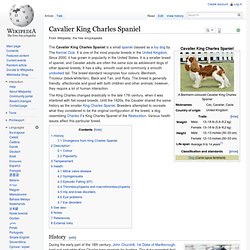
Until the 1920s, the Cavalier shared the same history as the smaller King Charles Spaniel. Breeders attempted to recreate what they considered to be the original configuration of the breed, a dog resembling Charles II's King Charles Spaniel of the Restoration. Various health issues affect this particular breed. History[edit] Cavalier King Charles Spaniel head, lesser stop, skull not inclined to be domed, with spot in centre of skull During the early part of the 18th century, John Churchill, 1st Duke of Marlborough, kept red and white King Charles type spaniels for hunting. Beagle. Beagles have been depicted in popular culture since Elizabethan times in literature and paintings, and more recently in film, television and comic books.
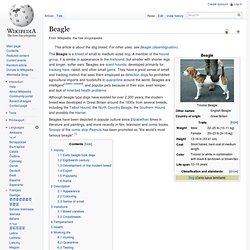
Snoopy of the comic strip Peanuts has been promoted as "the world's most famous beagle".[1] History[edit] Early beagle-type dogs[edit] Dogs of similar size and purpose to the modern Beagle[a] can be traced in Ancient Greece[2] back to around the 5th century BC. Xenophon, born around 430 BC, in his Treatise on Hunting or Cynegeticus refers to a hound that hunted hares by scent and was followed on foot.
From medieval times, beagle was used as a generic description for the smaller hounds, though these dogs differed considerably from the modern breed. Little small mitten-beagle, which may be companion for a ladies kirtle, and in the field will run as cunningly as any hound whatere, only their musick is very small like reeds.[7] Labrador Retriever. The Labrador Retriever, also known as simply Labrador or Lab, is one of several kinds of retrievers, a type of gun dog.
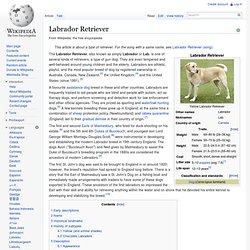
They are even-tempered and well-behaved around young children and the elderly. Labradors are athletic, playful, and the most popular breed of dog by registered ownership in Australia, Canada, New Zealand,[3] the United Kingdom,[4] and the United States (since 1991).[5] A favourite assistance dog breed in these and other countries, Labradors are frequently trained to aid people who are blind and people with autism, act as therapy dogs, and perform screening and detection work for law enforcement and other official agencies.
They are prized as sporting and waterfowl hunting dogs.[6] A few kennels breeding these grew up in England; at the same time a combination of sheep protection policy (Newfoundland) and rabies quarantine (England) led to their gradual demise in their country of origin.[7] The first St. Early descriptions[edit] Several early descriptions of the St. Pug. Jack Russell Terrier. The Jack Russell Terrier is a small terrier that has its origins in fox hunting; it is principally white-bodied and smooth, rough or broken-coated.
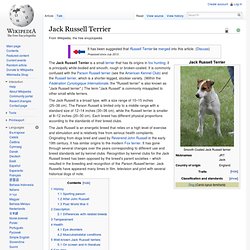
It is commonly confused with the Parson Russell terrier (see the American Kennel Club) and the Russell terrier, which is a shorter-legged, stockier variety. (Within the Fédération Cynologique Internationale, the "Russell terrier" is also known as "Jack Russell terrier".) The term "Jack Russell" is commonly misapplied to other small white terriers.
The Jack Russell is a broad type, with a size range of 10–15 inches (25–38 cm). The Parson Russell is limited only to a middle range with a standard size of 12–14 inches (30–36 cm), while the Russell terrier is smaller at 8–12 inches (20–30 cm). History Sporting parson The Fox terrier and Jack Russell terrier type dogs of today are all descended from dogs of that period, although documented pedigrees earlier than 1862 have not been found. After John Russell Post World War II Description Temperament. Dalmatian (dog) The Dalmatian is a breed of dog named after the historical region of Dalmatia.

The Dalmatian is noted for its unique black or liver spotted coat and was mainly used as a carriage dog in its early days. Today, this dog remains a well-loved family pet, and many dog enthusiasts enter their pets into kennel club competitions. A black-spotted Dalmatian female The Dalmatian is a mid-sized, well-defined, muscular dog with excellent endurance and stamina.
When full grown, its weight normally ranges between 35 and 70 pounds (16 and 32 kg) and it stands from 19 to 24 inches (48 to 61 cm) tall, with males usually slightly larger than females.[1] The body is as long from forechest to buttocks as it is tall at the withers, and the shoulders are laid back. Dalmatian puppies are born with plain white coats and their first spots usually appear within three weeks after birth. Newborn Dalmatian puppies Dalmatian puppies, three weeksA three-month old Dalmatian Dalmatian with liver spotted coat. Bichon Frise. Etymology and history[edit] Bichon Frise Though not considered a retriever or water dog, the Bichon, due to its ancestry as a sailor's dog, has an affinity for and enjoys water and retrieving.
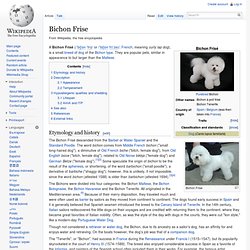
On the boats however, the dog's job was that of a companion dog. The "Tenerife", or "Bichon", had success in France during the Renaissance under Francis I (1515–1547), but its popularity skyrocketed in the court of Henry III (1574–1589). Great Pyrenees. Great Dane. The Great Dane is a German breed[1][2][3][4][5][6][7] of domestic dog (Canis lupus familiaris) known for its giant size.[8] The name of the breed in Germany is Deutsche Dogge (German Mastiff).
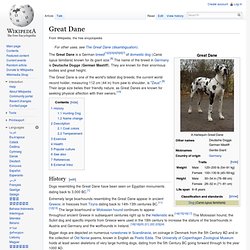
They are known for their enormous bodies and great height. History[edit] Dogs resembling the Great Dane have been seen on Egyptian monuments dating back to 3,000 BC.[1]